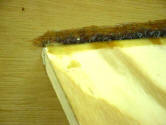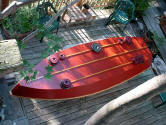|
Click images to enlarge |
|||
|
I enjoyed building the boat. All the wood joints were glued together with Gorilla Glue. It really foams up and expands when curing. There is no solvent for it, so any glue that got on my hands took several days to wear off on its own. Working with fiberglass was a new and messy experience, but after a while it got easier. I fiberglassed all inside and outside joints, and the whole hull bottom. Four inch fiberglass tape was a lot easier to work with than trying to cut large sheets of cloth into strips (the edges unravel too much). Coating everything with several coats of epoxy after each coat dried was the key to getting the joints as invisible as possible and avoiding a great deal of sanding later on. To spruce up the finished look of the boat, the existing pine plywood seats were covered with the same mahogany plywood and trimmed with solid 1” x 2” strips of mahogany to conceal their edges. For the topside rails of the boat, I ripped a 12’oak board into four strips: two 1/2 “ x 1” pieces, and two 3/4” x 1” pieces. On the 3/4" x 1” pieces I cut rabbet joints ( by ripping them again another 1/4" on one side with the blade on the table saw raised only 3/4" to form an “L” shaped piece). This concealed the top edge of the plywood of the sides of the boat. Then I had to make a piece to fit the point where they meet at the bow and cover the top of the stern to match. I used a belt sander to shape these pieces and make them all meet flush together. All unpainted wood pieces got three coats of gloss marine spar varnish. The painted sides and both sides of the bottom piece got two coats of oil based primer and two coats of latex exterior “porch and floor” paint. I mixed sand in with the paint I used to cover the floor of the boat to give it a non-slip finish (and conceal some of the messy fiberglass and epoxy joints). The name on the back was done with a stencil I made by enlarging a font I liked on a computer, printing it out and cutting the paper with an x-acto knife. I outlined the hand painted letters with a black fine-tipped magic marker. Overall, I spent a lot more time working on the skiff than I thought. Somehow, things always took more than twice as long as I anticipated, but I guess that’s to be expected when you want a finished product you can be proud of. I got the smallest electric trolling motor (30” shaft/30 lbs. of thrust), and it does about 5 knots with two passengers and a picnic basket (I verified this with a hand-held GPS). Many people smile and wave when they see us coming because it looks a lot like a classic wooden boat from a bye-gone era. While my wife and I were out on the Potomac one day, a passing fellow boater commented, “My, that’s a pretty thing”. I shouted back, “I know, that’s why I married her!”
|
|||



















